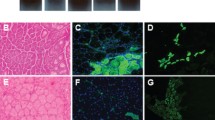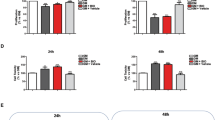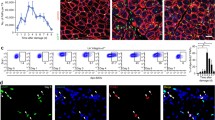Abstract
Tumour Necrosis Factor (TNF) plays a major role in exacerbating necrosis of dystrophic muscle; however, the precise molecular mechanism underlying this effect of TNF is unknown. This study investigates the role that p53 plays in TNF-mediated necrosis of dystrophic myofibres by inhibiting p53 using pifithrin-α and three pifithrin-β analogues. Tissue culture studies using C2C12 myoblasts established that pifithrin-α was toxic to differentiating myoblasts at concentrations greater than 10 μM. While non-toxic concentrations of pifithrin-α did not prevent the TNF-mediated inhibition of myoblast differentiation, Western blots indicated that nuclear levels of p53 were higher in TNF-treated myoblasts indicating that TNF does elevate p53. In contrast, in vivo studies in adult mdx mice showed that pifithrin-α significantly reduced myofibre necrosis that resulted from voluntary wheel running over 48 h. These results support the hypothesis that p53 plays some role in TNF-mediated necrosis of dystrophic muscle and present a potential new target for therapeutic interventions.








Similar content being viewed by others
References
Emery EH (2002) The muscular dystrophies. Lancet 359:687–695
Hoffman EP, Brown RH, Kunkel LM (1987) Dystrophin: the protein product of the Duchenne muscular dystrophy locus. Cell 51:919–928
Petrof BJ, Shrager JB, Stedman HH, Kelly AM, Sweeney HL (1993) Dystrophin protects the sacolemma from stresses developed durign muscle contraction. Proc Natl Acad Sci USA 90(8):3710-3714
Ehmsen J, Poon E, Davies K (2002) The dystrophin-associated protein complex. J Cell Sci 115:2801–2803
Bulfield G, Siller WG, Wright PAL, Moore KJ (1984) X chromosome-linked muscular dystrophy (mdx) in the mouse. Proc Natl Acad Sci USA 81:1189–1192
Lapidos KA, Kakkar R, McNally EM (2004) The dystrophin glycoprotein complex: signalling strength and integrity for the sarcolemma. Circ Res 94:1023–1031
Spencer MJ, Tidball JG (2001) Do immune cells promote the pathology of dystrophin-deficient myopathies? Neuromuscul Disord 11:556–564
Strober JB (2006) Therapeutics in duchenne muscular dystrophy. NeuroRx 3:225–234
Whitehead NP, Yeung EW, Allen DG (2006) Muscle damage in mdx (dystrophic) mice: role of calcium and reactive oxygen species. Clin Exp Pharmacol Physiol 33:657–662
Porter JD, Khanna S, Kaminski HJ, Rao JS, Merriam AP, Richmonds CR, Leahy P, Li J, Guo W, Andrade FH (2002) A chronic inflammatory response dominates the skeletal muscle molecular signature in dystrophin-deficient mdx mice. Hum Mol Genet 11:263–272
Tidball JG (2005) Inflammatory processes in muscle injury and repair. Am J Physiol Regul Integr Comp Physiol 288:R345–R353
Hodgetts S, Radley H, Davies M, Grounds MD (2006) Reduced necrosis of dystrophic muscle by depletion of host neutrophils, or blocking TNFalpha function with Etanercept in mdx mice. Neuromuscul Disord 16:591–602
Grounds MD, Torrisi J (2004) Anti-TNFa (Remicade) therapy protects dystrophic skeletal muscle from necrosis. FASEB J 18:676–682
Pierno S, Nico B, Burdi R, Liantonio A, Didonna MP, Cippone V, Fraysse B, Rolland JF, Mangieri D, Andreetta F, Ferro P, Camerino C, Zallone A, Confalonieri P, De Luca A (2007) Role of tumour necrosis factor alpha, but not of cyclo-oxygenase-2-derived eicosanoids, on functional and morphological indices of dystrophic progression in mdx mice: a pharmacological approach. Neuropathol Appl Neurobiol 33:344–359
Radley HG, Davies MJ, Grounds MD (2008) Reduced muscle necrosis and long-term benefits in dystrophic mdx mice after cV1q (blockade of TNF) treatment. Neuromuscul Disord 18:227–238
Radley HG, Grounds MD (2006) Cromolyn administration (to block mast cell degranulation) reduces necrosis of dystrophic muscle in mdx mice. Neurobiol Disord 23:387–397
Cheung EV, Tidball JG (2003) Administration of the non-steroidal anti-inflammatory drug ibuprofen increases macrophage concentrations but reduces necrosis during modified muscle use. Inflamm Res 52:170–176
Wehling M, Spencer MJ, Tidball JG (2001) A nitric oxide synthase transgene ameliorates muscular dystrophy in mdx mice. J Cell Biol 155:123–131
Messina S, Bitto A, Aguennouz M, Minutoli L, Monici MC, Altavilla D, Squadrito F, Vita G (2006) Nuclear factor kappa-B blockade reduces skeletal muscle degeneration and enhances muscle function in Mdx mice. Exp Neurol 198:234–241
Kuru S, Inukai A, Kato T, Liang Y, Kimura S, Sobue G (2003) Expression of tumor necrosis factor-alpha in regenerating muscle fibers in inflammatory and non-inflammatory myopathies. Acta Neuropathol (Berl) 105:217–224
Grounds MD, Radley HG, Gebski BG, Bogoyevitch MA, Shavlakadze T (2008) Implications of cross-talk between tumour necrosis factor and insulin-like growth factor-1 signalling in skeletal muscle. Clin Exp Pharmacol Physiol 35(7):846–851
Saito K, Kobayashi D, Komatsu M, Yajima T, Yagihashi A, Ishikawa Y, Minami R, Watanabe N (2000) A sensitive assay of tumor necrosis factor alpha in sera from Duchenne muscular dystrophy patients. Clin Chem 46:1703–1704
Radley HG, De Luca A, Lynch GS, Grounds MD (2007) Duchenne muscular dystrophy: Focus on pharmaceutical and nutritional interventions. Int J Biochem Cell Biol 39:469–477
Biggar WD, Harris VA, Eliasoph L, Alman B (2006) Long-term benefits of deflazacort treatment for boys with Duchenne muscular dystrophy in their second decade. Neuromuscul Disord 16:249–255
Bushby K, Muntoni F, Urtizberea A, Hughes R, Griggs R (2004) Report on the 124th ENMC international workshop. Treatment of duchenne muscular dystrophy; defining the gold standards of management in the use of corticosteroids. In: neuromuscular disorders. Naarden, The Netherlands, pp 526–534
Arthur PG, Grounds MD, Shavlakadze T (2008) Oxidative stress as a therapeutic target during muscle wasting: considering the complex interactions. Curr Opin Clin Nutr Metab Care 11:408–416
Foulstone EJ, Meadows KA, Holly JM, Stewart CE (2001) Insulin-like growth factors (IGF-I and IGF-II) inhibit C2 skeletal myoblast differentiation and enhance TNF alpha-induced apoptosis. J Cell Physiol 189:207–215
Meadows KA, Holly JMP, Stewart CEH (2000) Tumor necrosis factor-a-induced apoptosis is associated with suppression of insulin-like growth factor binding protein-5 secretion in differentiating murine skeletal myoblasts. J Cell Physiol 183:330–337
Coletti D, Yang E, Marazzi G, Sassoon D (2002) TNFa inhibits skeletal myogenesis through a PW1-dependent pathway by recruitment of caspase pathways. EMBO J 21:631–642
Reid MB, Lannergren J, Westerblad H (2002) Respiratory and limb muscle weakness induced by tumor necrosis factor-alpha: involvement of muscle myofilaments. Am J Respir Crit Care Med 166:479–484
Dempsey PW, Doyle SE, He JQ, Cheng G (2003) The signaling adaptors and pathways activated by TNF superfamily. Cytokine Growth Factor Rev 14:193–209
Tolosa L, Morla M, Iglesias A, Busquets X, Llado J, Olmos G (2005) IFN-gamma prevents TNF-alpha-induced apoptosis in C2C12 myotubes through down-regulation of TNF-R2 and increased NF-kappaB activity. Cell Signal 17:1333–1342
Clark IA (2007) How TNF was recognized as a key mechanism of disease. Cytokine Growth Factor Rev 18:335–343
Schwarzkopf M, Coletti D, Sassoon D, Marazzi G (2006) Muscle cachexia is regulated by a p53-PW1/Peg3-dependent pathway. Genes Dev 20:3440–3452
Marsolais D, Cote CH, Frenette J (2007) Pifithrin-alpha, an inhibitor of p53 transactivation, alters the inflammatory process and delays tendon healing following acute injury. Am J Physiol Regul Integr Comp Physiol 292:R321–R327
Schafer T, Scheuer C, Roemer K, Menger MD, Vollmar B (2003) Inhibition of p53 protects liver tissue against endotoxin-induced apoptotic and necrotic cell death. Faseb J 17:660–667
Dogra C, Srivastava DS, Kumar A (2008) Protein-DNA array-based identification of transcription factor activities differentially regulated in skeletal muscle of normal and dystrophin-deficient mdx mice. Mol Cell Biochem 312:17–24
Komarov PG, Komarova EA, Kondratov RV, Christov-Tselkov K, Coon JS, Chernov MV, Gudkov AV (1999) A chemical inhibitor of p53 that protects mice from the side effects of cancer therapy. Science 285:1733–1737
Burdelya LG, Komarova EA, Hill JE, Browder T, Tararova ND, Mavrakis L, Dicorleto PE, Folkman J, Gudkov AV (2006) Inhibition of p53 response in tumor stroma improves efficacy of anticancer treatment by increasing antiangiogenic effects of chemotherapy and radiotherapy in mice. Cancer Res 66:9356–9361
Gudkov AV, Komarova EA (2005) Prospective therapeutic applications of p53 inhibitors. Biochem Biophys Res Commun 331:726–736
Strom E, Sathe S, Komarov PG, Chernova OB, Pavlovska I, Shyshynova I, Bosykh DA, Burdelya LG, Macklis RM, Skaliter R, Komarova EA, Gudkov AV (2006) Small-molecule inhibitor of p53 binding to mitochondria protects mice from gamma radiation. Nat Chem Biol 2:474–479
Komarova EA, Gudkov AV (2000) Suppression of p53: a new approach to overcome side effects of antitumor therapy. Biochemistry (Moscow) 65:41–48
Barchechath SD, Tawatao RI, Corr M, Carson DA, Cottam HB (2005) Inhibitors of apoptosis in lymphocytes: synthesis and biological evaluation of compounds related to pifithrin-alpha. J Med Chem 48:6409–6422
Pietrancosta N, Moumen A, Dono R, Lingor P, Planchamp V, Lamballe F, Bahr M, Kraus JL, Maina F (2006) Imino-tetrahydro-benzothiazole derivatives as p53 inhibitors: discovery of a highly potent in vivo inhibitor and its action mechanism. J Med Chem 49:3645–3652
Yaffe D, Saxel O (1977) Serial passaging and differentiation of myogenic cells isolated from dystrophic mouse muscle. Nature 270:725–727
Wang J, Ouyang W, Li J, Wei L, Ma Q, Zhang Z, Tong Q, He J, Huang C (2005) Loss of tumor suppressor p53 decreases PTEN expression and enhances signaling pathways leading to activation of activator protein 1 and nuclear factor kappaB induced by UV radiation. Cancer Res 65:6601–6611
Miller JB (1990) Myogenic programs of mouse muscle cell lines: expression of myosin heavy chain isoforms, MyoD1, and myogenin. J Cell Biol 111:1149–1159
Machida S, Booth FW (2004) Increased nuclear proteins in muscle satellite cells in aged animals as compared to young growing animals. Exp Gerontol 39:1521–1525
Schaller MD (2001) Paxillin: a focal adhesion-associated adaptor protein. Oncogene 20:6459–6472
Halevy O, Novitch BG, Spicer DB, Skapek SX, Rhee J, Hannon GJ, Beach D, Lassar AB (1995) Correlation of terminal cell cycle arrest of skeletal muscle with induction of p21 by MyoD. Science 267:1018–1021
Soddu S, Blandino G, Scardigli R, Coen S, Marchetti A, Rizzo MG, Bossi G, Cimino L, Crescenzi M, Sacchi A (1996) Interference with p53 protein inhibits hematopoietic and muscle differentiation. J Cell Biol 134:193–204
Dupont-Versteegden EE, McCarter RJ, Katz MS (1994) Voluntary exercise decreases progression of muscular dystrophy in diaphragm of mdx mice. J Appl Physiol 77:1736–1741
Gary RK, Jensen DA (2005) The p53 inhibitor pifithrin-alpha forms a sparingly soluble derivative via intramolecular cyclization under physiological conditions. Mol Pharm 2:462–474
Pietrancosta N, Maina F, Dono R, Moumen A, Garino C, Laras Y, Burlet S, Quelever G, Kraus J-L (2005) Novel cyclized Pifithrin -(alpha) p53 inactivators: synthesis and biological studies. Bioorg Med Chem Lett 15:1561–1564
Appella E, Anderson CW (2001) Post-translational modifications and activation of p53 by genotoxic stresses. Eur J Biochem 268:2764–2772
Soberanes S, Panduri V, Mutlu GM, Ghio A, Bundinger GR, Kamp DW (2006) p53 mediates particulate matter-induced alveolar epithelial cell mitochondria-regulated apoptosis. Am J Respir Crit Care Med 174:1229–1238
Proietti De Santis L, Balajee AS, Lorenti Garcia C, Pepe G, Worboys AM, Palitti F (2003) Inhibition of p53, p21 and Bax by pifithrin-alpha does not affect UV induced apoptotic response in CS-B cells. DNA Repair (Amst) 2:891–900
Wineinger MA, Walsh SA, Abresch RT (1998) The effect of age and temperature on mdx muscle fatigue. Muscle Nerve 21:1075–1077
Archer JD, Vargas CC, Anderson JE (2006) Persistent and improved functional gain in mdx dystrophic mice after treatment with L-arginine and deflazacort. Faseb J 20:738–740
Grounds MD, Radley HG, Lynch GS, Nagaraju K, De Luca A (2008) Towards developing standard operating procedures for pre-clinical testing in the mdx mouse model of Duchenne muscular dystrophy. Neurobiol Dis 31:1–19
De Luca A, Nico B, Liantonio A, Didonna MP, Fraysse B, Pierno S, Burdi R, Mangieri D, Rolland JF, Camerino C, Zallone A, Confalonieri P, Andreetta F, Arnoldi E, Courdier-Fruh I, Magyar JP, Frigeri A, Pisoni M, Svelto M, Conte Camerino D (2005) A multidisciplinary evaluation of the effectiveness of cyclosporine a in dystrophic mdx mice. Am J Pathol 166:477–489
Carter GT, Wineinger MA, Walsh SA, Horasek SJ, Abresch RT, Fowler WM Jr (1995) Effect of voluntary wheel-running exercise on muscles of the mdx mouse. Neuromuscul Disord 5:323–332
Drane P, Leblanc V, Miro-Mur F, Saffroy R, Debuire B, May E (2002) Accumulation of an inactive form of p53 protein in cells treated with TNF alpha. Cell Death Differ 9:527–537
Tergaonkar V, Perkins ND (2007) p53 and NF-kappaB crosstalk: IKKalpha tips the balence. Mol Cell 26:158–159
Kawauchi K, Araki K, Tobiume K, Tanaka N (2008) Activated p53 induces NF-κB DNA binding but suppresses its transcriptional activation. Biochem Biophys Res Commun 372:137–141
Perkins ND (2007) Integrating cell-signalling pathways with NF-kB and IKK function. Nat Rev Mol Cell Biol 8:49–62
Peterson JM, Guttridge DC (2008) Skeletal muscle diseases, inflammation, and NF-kappaB signaling: insights and opportunities for therapeutic intervention. Int Rev Immunol 27:375–387
Acknowledgements
This research was funded by a grant (MG/TS) from the National Health and Medical Research Council of Australia. We thank David Sassoon and Giovanna Marazzi (Paris) for suggesting the use of pifithrin-α for this study and Bijanka Gebski (UWA) for assistance in tissue culture studies. In addition, helpful discussions with Dr Trevor Payne (UWA) on selecting suitable pifithrin analogues were greatly appreciated.
Author information
Authors and Affiliations
Corresponding author
Rights and permissions
About this article
Cite this article
Waters, F.J., Shavlakadze, T., McIldowie, M.J. et al. Use of pifithrin to inhibit p53-mediated signalling of TNF in dystrophic muscles of mdx mice. Mol Cell Biochem 337, 119–131 (2010). https://doi.org/10.1007/s11010-009-0291-2
Received:
Accepted:
Published:
Issue Date:
DOI: https://doi.org/10.1007/s11010-009-0291-2




